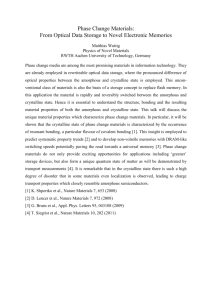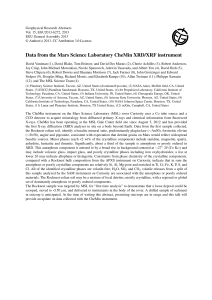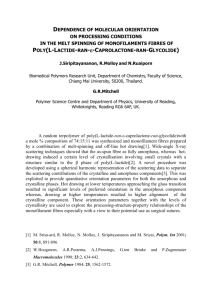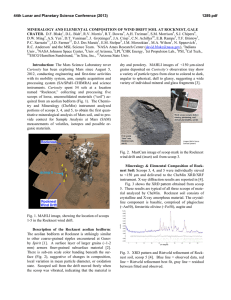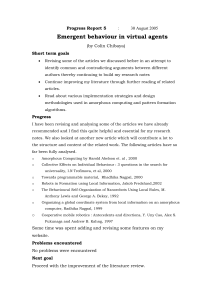THE AMORPHOUS COMPONENT IN MARTIAN BASALTIC SOIL IN GLOBAL PERSPECTIVE... MSL AND MER MISSIONS. , D.W. Ming , D.F. Blake
advertisement
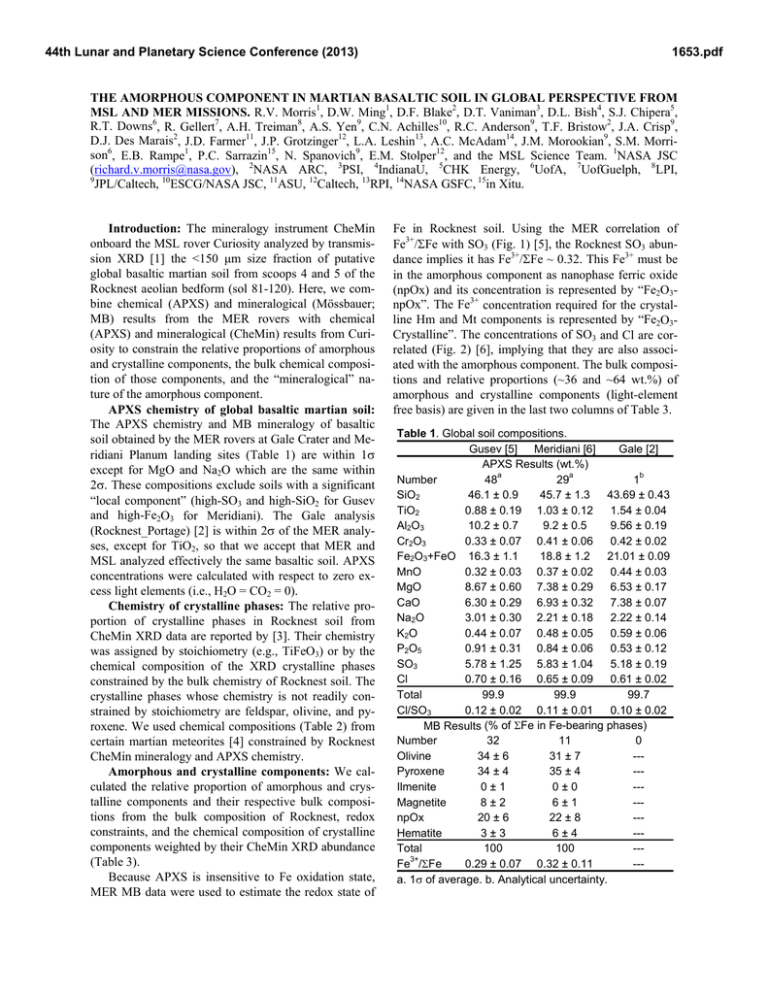
44th Lunar and Planetary Science Conference (2013) 1653.pdf THE AMORPHOUS COMPONENT IN MARTIAN BASALTIC SOIL IN GLOBAL PERSPECTIVE FROM MSL AND MER MISSIONS. R.V. Morris1, D.W. Ming1, D.F. Blake2, D.T. Vaniman3, D.L. Bish4, S.J. Chipera5, R.T. Downs6, R. Gellert7, A.H. Treiman8, A.S. Yen9, C.N. Achilles10, R.C. Anderson9, T.F. Bristow2, J.A. Crisp9, D.J. Des Marais2, J.D. Farmer11, J.P. Grotzinger12, L.A. Leshin13, A.C. McAdam14, J.M. Morookian9, S.M. Morrison6, E.B. Rampe1, P.C. Sarrazin15, N. Spanovich9, E.M. Stolper12, and the MSL Science Team. 1NASA JSC (richard.v.morris@nasa.gov), 2NASA ARC, 3PSI, 4IndianaU, 5CHK Energy, 6UofA, 7UofGuelph, 8LPI, 9 JPL/Caltech, 10ESCG/NASA JSC, 11ASU, 12Caltech, 13RPI, 14NASA GSFC, 15in Xitu. Introduction: The mineralogy instrument CheMin onboard the MSL rover Curiosity analyzed by transmission XRD [1] the <150 μm size fraction of putative global basaltic martian soil from scoops 4 and 5 of the Rocknest aeolian bedform (sol 81-120). Here, we combine chemical (APXS) and mineralogical (Mössbauer; MB) results from the MER rovers with chemical (APXS) and mineralogical (CheMin) results from Curiosity to constrain the relative proportions of amorphous and crystalline components, the bulk chemical composition of those components, and the “mineralogical” nature of the amorphous component. APXS chemistry of global basaltic martian soil: The APXS chemistry and MB mineralogy of basaltic soil obtained by the MER rovers at Gale Crater and Meridiani Planum landing sites (Table 1) are within 1 except for MgO and Na2O which are the same within 2. These compositions exclude soils with a significant “local component” (high-SO3 and high-SiO2 for Gusev and high-Fe2O3 for Meridiani). The Gale analysis (Rocknest_Portage) [2] is within 2 of the MER analyses, except for TiO2, so that we accept that MER and MSL analyzed effectively the same basaltic soil. APXS concentrations were calculated with respect to zero excess light elements (i.e., H2O = CO2 = 0). Chemistry of crystalline phases: The relative proportion of crystalline phases in Rocknest soil from CheMin XRD data are reported by [3]. Their chemistry was assigned by stoichiometry (e.g., TiFeO3) or by the chemical composition of the XRD crystalline phases constrained by the bulk chemistry of Rocknest soil. The crystalline phases whose chemistry is not readily constrained by stoichiometry are feldspar, olivine, and pyroxene. We used chemical compositions (Table 2) from certain martian meteorites [4] constrained by Rocknest CheMin mineralogy and APXS chemistry. Amorphous and crystalline components: We calculated the relative proportion of amorphous and crystalline components and their respective bulk compositions from the bulk composition of Rocknest, redox constraints, and the chemical composition of crystalline components weighted by their CheMin XRD abundance (Table 3). Because APXS is insensitive to Fe oxidation state, MER MB data were used to estimate the redox state of Fe in Rocknest soil. Using the MER correlation of Fe3+/Fe with SO3 (Fig. 1) [5], the Rocknest SO3 abundance implies it has Fe3+/Fe ~ 0.32. This Fe3+ must be in the amorphous component as nanophase ferric oxide (npOx) and its concentration is represented by “Fe2O3npOx”. The Fe3+ concentration required for the crystalline Hm and Mt components is represented by “Fe2O3Crystalline”. The concentrations of SO3 and Cl are correlated (Fig. 2) [6], implying that they are also associated with the amorphous component. The bulk compositions and relative proportions (~36 and ~64 wt.%) of amorphous and crystalline components (light-element free basis) are given in the last two columns of Table 3. Table 1. Global soil compositions. Gusev [5] Meridiani [6] Gale [2] APXS Results (wt.%) Number 48a 29a 1b SiO2 46.1 ± 0.9 45.7 ± 1.3 43.69 ± 0.43 TiO2 0.88 ± 0.19 1.03 ± 0.12 1.54 ± 0.04 10.2 ± 0.7 9.2 ± 0.5 9.56 ± 0.19 Al2O3 Cr2O3 0.33 ± 0.07 0.41 ± 0.06 0.42 ± 0.02 18.8 ± 1.2 21.01 ± 0.09 Fe2O3+FeO 16.3 ± 1.1 MnO 0.32 ± 0.03 0.37 ± 0.02 0.44 ± 0.03 MgO 8.67 ± 0.60 7.38 ± 0.29 6.53 ± 0.17 CaO 6.30 ± 0.29 6.93 ± 0.32 7.38 ± 0.07 3.01 ± 0.30 2.21 ± 0.18 2.22 ± 0.14 Na2O K2O 0.44 ± 0.07 0.48 ± 0.05 0.59 ± 0.06 0.91 ± 0.31 0.84 ± 0.06 0.53 ± 0.12 P2O5 SO3 5.78 ± 1.25 5.83 ± 1.04 5.18 ± 0.19 Cl 0.70 ± 0.16 0.65 ± 0.09 0.61 ± 0.02 Total 99.9 99.9 99.7 Cl/SO3 0.12 ± 0.02 0.11 ± 0.01 0.10 ± 0.02 MB Results (% of Fe in Fe-bearing phases) Number 32 11 0 Olivine 34 ± 6 31 ± 7 --Pyroxene 34 ± 4 35 ± 4 --Ilmenite 0±1 0±0 --Magnetite 8±2 6±1 --npOx 20 ± 6 22 ± 8 --Hematite 3±3 6±4 --Total 100 100 --Fe3+/Fe 0.29 ± 0.07 0.32 ± 0.11 --a. 1 of average. b. Analytical uncertainty. 44th Lunar and Planetary Science Conference (2013) Refs: [1] Blake et al. (2012) JGR; (2013) LPSC44. [2] Yen et al. (2013) LPSC44. [3] Bish et al. (2013) LPSC44. [4] Papike et al. (2009) GCA. [5] Morris et al. (2006a, b, 2008) JGR. [6] Yen et al. (2005) EPSL; Ming et al. (2006) JGR; Morris et al. (2006a, b, 2008) JGR. [7] Bibring et al. (2006) Science. 0.6 Fe3+/Sigma-Fe Table 2. Crystalline component compositions (wt.%) Plagioclase Olivine Pyroxene Or3Ab49An48 Fa39Fo61 Wo21En40Fs38 SiO2 55.9 36.3 51.0 TiO2 ----0.40 Al2O3 27.45 0.06 1.01 Cr2O3 --0.02 0.30 0.73 --0.49 Fe2O3 FeO --33.2 22.7 MnO --0.63 0.69 MgO 0.10 29.7 13.7 CaO 10.13 0.25 10.00 Na2O 5.66 --0.13 0.46 ----K2O Total 100.4 100.3 100.3 example from volcanic emanations by specific anion adsorption by npOx, when aqueous activity decreased in intensity on Mars [7]. The crystalline component in global basaltic soil may be predominantly the product of physical weathering after this time. Gusev dust on rock Gusev soil Meridiani soil Gale Rocknest soil 0.4 0.2 Unscuff Scuff SO3 for Portage Fig 1. 0.0 0 2 4 6 8 10 1.2 Unscuff Cl (wt. %) Because the detected crystalline phases are nominally anhydrous, the amorphous component must contain the H2O and CO2 detected by MSL-SAM. The relative proportion of the amorphous component in Rocknest will be 36 wt.% when these contributions are quantified and taken into account. The high SiO2/Al2O3 ratio for the amorphous component implies allophane is not prevalent, and the FeO concentration implies an amorphous Fe2+-bearing component (basaltic glass?) or an underestimated Fe3+/Fe ratio. The low SiO2 and high TiO2 and Fe2O3 (npOx) concentrations compared with bulk soil suggest aqueous weathering of basaltic precursors under near neutral conditions followed by accumulation of S and Cl, for 1653.pdf Scuff 0.8 0.4 Portage Fig 2. 0.0 0 2 4 6 8 10 SO3 (wt.% ) Table 3. Chemical composition and relative proportion of Rocknest soil amorphous and crystalline components Remove Crystalline Componenta Bulk Composition Amorphous Crystalline Wt.% Component Redox Plag Ol Px Ilm Hm Mt Anh Qz 43.7 27.5 22.8 13.6 13.6 13.6 13.6 13.6 12.6 35.3 48.4 SiO2 TiO2 1.54 1.54 1.54 1.47 1.26 1.26 1.26 1.26 1.26 3.52 0.42 9.6 1.6 1.6 1.4 1.4 1.4 1.4 1.4 1.4 3.9 12.7 Al2O3 0.42 0.42 0.42 0.37 0.37 0.37 0.37 0.37 0.37 1.03 0.08 Cr2O3 Fe2O3-Crystalline 1.6 1.3 1.3 1.3 1.3 0.8 0.0 0.0 0.0 0.0 2.4 6.8 6.8 6.8 6.8 6.8 6.8 6.8 6.8 6.8 19.0 -0.1 Fe2O3-npOx FeO 12.7 12.7 8.3 4.3 4.1 4.1 3.7 3.7 3.7 10.4 13.9 MnO 0.44 0.44 0.36 0.23 0.23 0.23 0.23 0.23 0.23 0.65 0.32 0.50 9.94 MgO 6.53 6.50 2.63 0.18 0.18 0.18 0.18 0.18 0.18 6.27 8.01 CaO 7.38 4.44 4.41 2.61 2.61 2.61 2.61 2.24 2.24 Na2O 2.22 0.58 0.58 0.55 0.55 0.55 0.55 0.55 0.55 1.55 2.60 K2O 0.59 0.46 0.46 0.46 0.46 0.46 0.46 0.46 0.46 1.28 0.20 0.53 0.53 0.53 0.53 0.53 0.53 0.53 0.53 0.53 1.48 -0.01 P2O5 SO3-Crystalline 0.53 0.53 0.53 0.53 0.53 0.53 0.53 0.00 0.00 0.00 0.83 4.65 4.65 4.65 4.65 4.65 4.65 4.65 4.65 4.65 13.02 -0.08 SO3-Amorphous 1.71 -0.01 Cl 0.61 0.61 0.61 0.61 0.61 0.61 0.61 0.61 0.61 Total 99.7 70.6 57.6 39.5 39.1 38.6 37.5 36.6 35.6 99.7 99.7 XRD Crystalline 45.4 20.3 28.2 0.6 0.8 1.7 1.4 1.6 0.0 100.0 Whole Sample 36.1 63.9 29 13 18 0.4 0.5 1.1 0.9 1.0 a Plag=plagioclase; Ol=olivine; Px=pyroxene; Ilm=ilmenite; Hm=hematite; Mt=magnetite; Anh=anhydrite; Qz=quartz.
